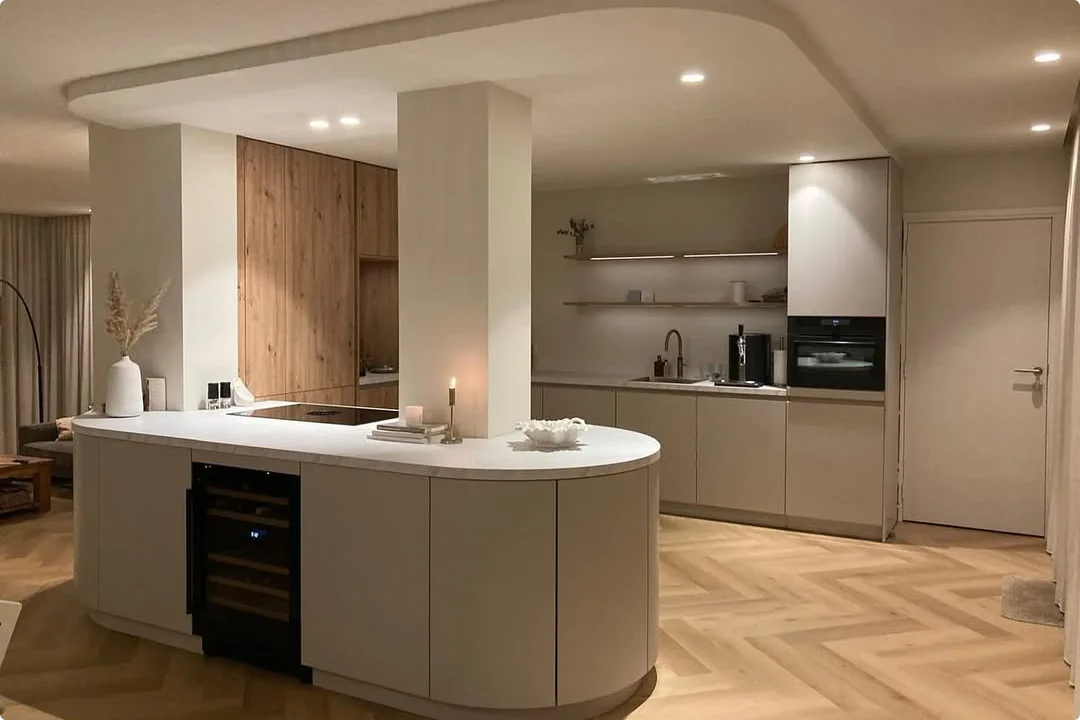
You know what’s cool about Japandi kitchens? They mix two totally different styles and somehow make them best friends.
It’s Japanese simplicity meeting Scandinavian coziness. Clean lines, warm wood, and spaces that just feel… calm.
I started looking into Japandi kitchen ideas because my own kitchen was stressing me out. Too much stuff everywhere. Too many colors fighting for attention.
Japandi fixes that. It’s about keeping things simple but not boring. Natural materials that actually make you feel good when you walk into the room.
Think light wood cabinets, neutral colors, and maybe a plant or two. Nothing fancy or complicated.
The best part? You don’t need a huge kitchen or a massive budget to pull this off. Some of these ideas work in tiny apartments. Some work in big open spaces.
I’m going to show you some different ways people are doing Japandi kitchens right now. Some are super minimal. Some have a bit more personality.
But they all share that same peaceful, put-together vibe that makes you want to cook more and stress less.
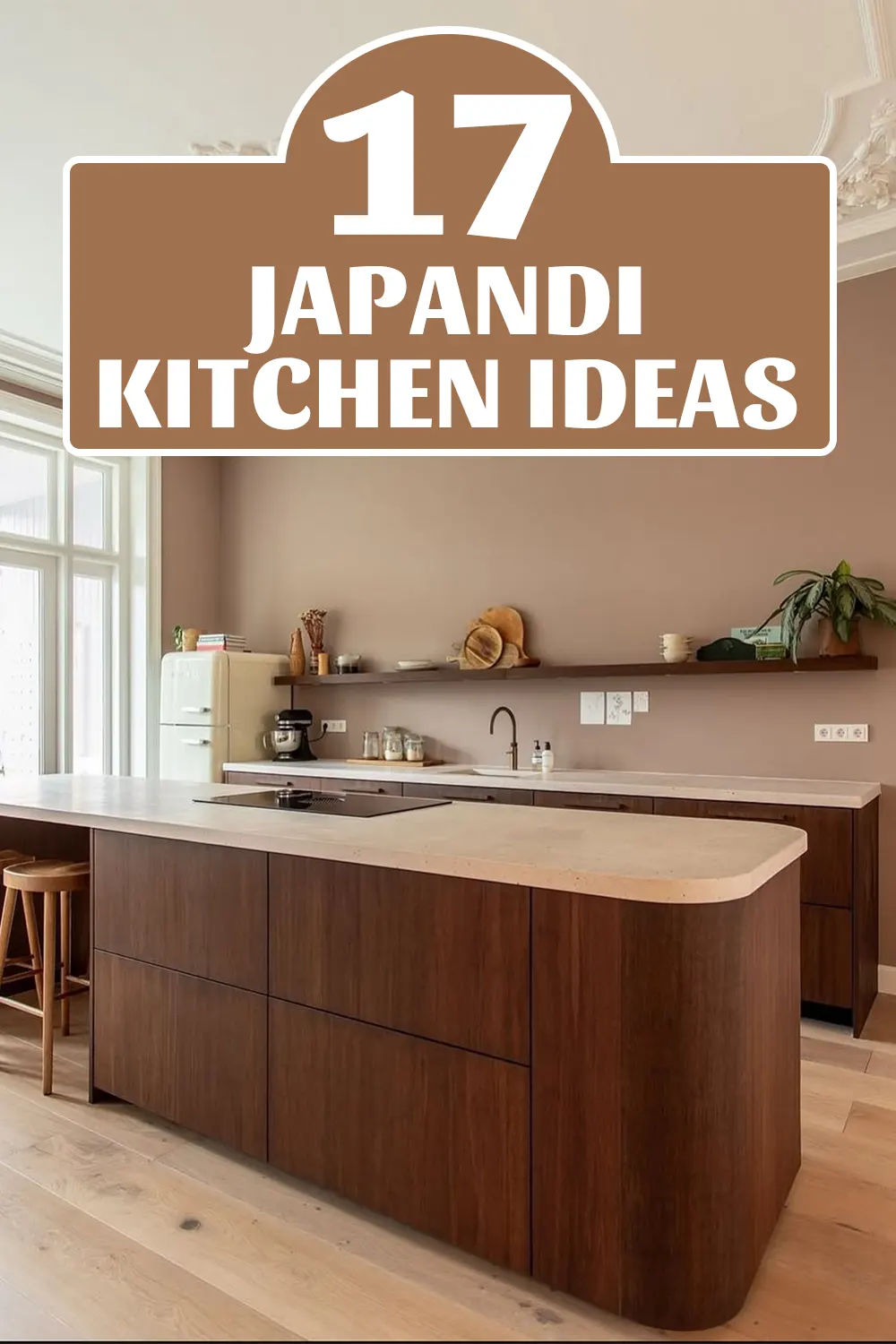
Creating a Japandi Kitchen on a Budget
Look, I get it. Not everyone has a huge budget sitting around.
Paint is honestly your best friend here. Grab a couple cans in beige or soft gray. Maybe that warm white everyone’s using now. Your walls will feel different in like a weekend.
Cabinet hardware is next on my list. Those old brass handles can go. I found matte black pulls at Home Depot for super cheap, and suddenly my cabinets looked expensive. Weird how that works.
Peel-and-stick backsplash saved me when I was renting. The new ones don’t look fake anymore. Just saying.
Clear your counters off. Costs nothing. I stuck my toaster in the cabinet and only bring it out when I need it. The coffee maker lives in the pantry now. Sounds annoying but you get used to it fast.
Plants help too. I got a little herb thing from the grocery store for like eight dollars. Sits on the windowsill and makes everything look more put together.
My cabinets were this awful orange oak from the 90s. Spent a few weekends sanding them down and restaining. My back hurt, but I saved probably three grand doing it myself.
Thrift stores have bar stools sometimes. Found two wooden ones for thirty bucks total. They were scratched up but nothing sandpaper couldn’t fix.
Do one thing at a time. I started with just the area around my sink. Then moved to the island later. Trying to do everything at once makes you crazy and broke.
Also Read: 21 Navy Blue Kitchen Ideas
Mistakes to Avoid When Designing a Japandi Kitchen
Don’t get so into the minimal thing that your kitchen stops working.
My friend cleared everything off her counters and then had nowhere to cut vegetables. She was chopping on her stove because the cutting board wouldn’t fit anywhere. Don’t be like that.
Too many wood colors makes things look weird. I learned this the hard way when I mixed oak cabinets with walnut shelves and cherry bar stools. My kitchen looked drunk.
Texture matters more than I thought it would. Everything smooth and flat feels like a hospital. Throw in a basket or some linen dish towels. Something that isn’t just hard and shiny.
That trendy tile you’re eyeing? Maybe wait. I almost got this geometric backsplash that was everywhere in 2019. Thank god I didn’t because I’d hate it now.
Lighting is huge. One ceiling light makes everything look flat and boring. I added some pendant lights and those stick-on LEDs under the cabinets. Way better.
Open shelves are pretty until you stack them with every mug you own. I keep like four things on mine. Anything more starts looking messy.
Cheap handles feel cheap when you grab them fifty times a day. Spend a little extra there. You’ll notice.
All white sounds good until you’re standing in what feels like a dentist’s office. Wood tones warm things up. Trust me on this.
Take your time buying stuff. I rushed and got this vase I didn’t even like just to fill space on a shelf. It sat there for six months before I finally donated it.
And those “Japandi collection” signs at Target? Skip them. The whole point is less stuff, better stuff. Not more stuff with the right label on it.
Also Read: 21 Sage Green Kitchen Ideas
17 Beautiful Japandi Kitchens That Actually Work
Twilight Grove
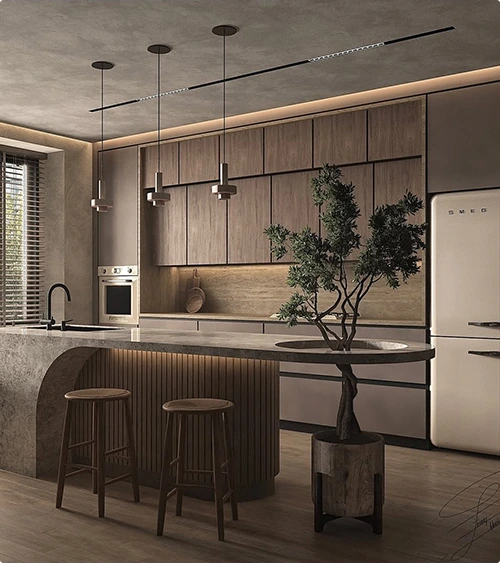
That curved island with the fluted front? It’s basically the star of this kitchen. The warm wood cabinets stretch all the way to the ceiling, which makes the room feel taller without trying too hard.
And can we talk about that bonsai tree for a second? It brings in just enough nature without going overboard. The black pendant lights and that hidden LED strip along the ceiling create this moody, evening vibe that makes you want to pour some tea and just hang out.
Sky High Serenity
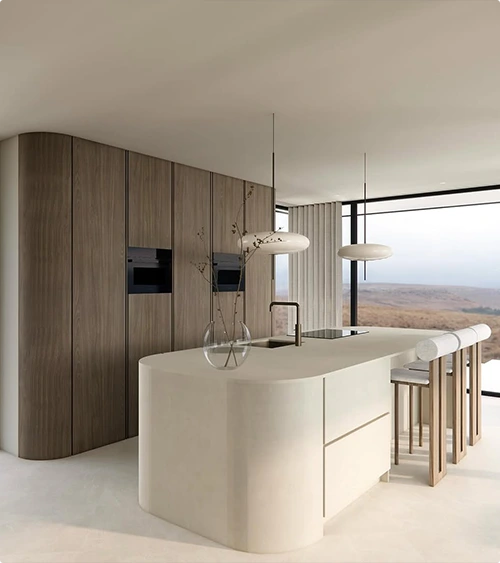
The sculptural island here looks like it’s floating in the middle of all that clean space. Those floor-to-ceiling windows basically turn the view into living art, which is the whole point of Japandi design anyway.
The soft, organic pendant lights balance out the hard lines of the cabinetry. Everything feels open and breathable, like the room itself is taking a deep breath.
Morning Light
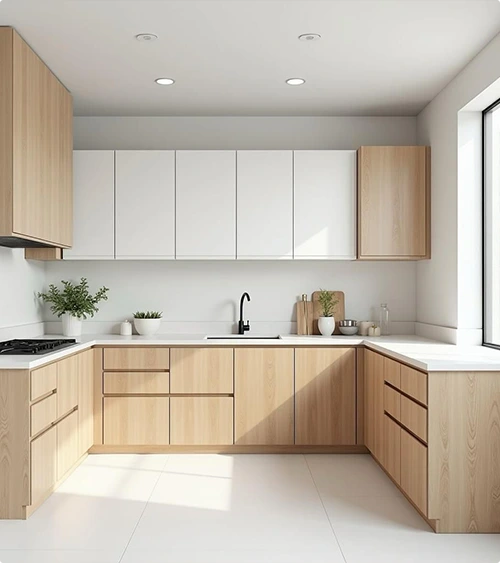
This U-shaped layout is perfect if you don’t have a massive kitchen but still want it to feel spacious. The mix of light wood lower cabinets and crisp white uppers keeps things interesting without getting too busy.
Natural light floods in from that big window, hitting the white counters just right. Sometimes the simplest setups are the ones that work best for actual cooking and living.
Garden Reflection
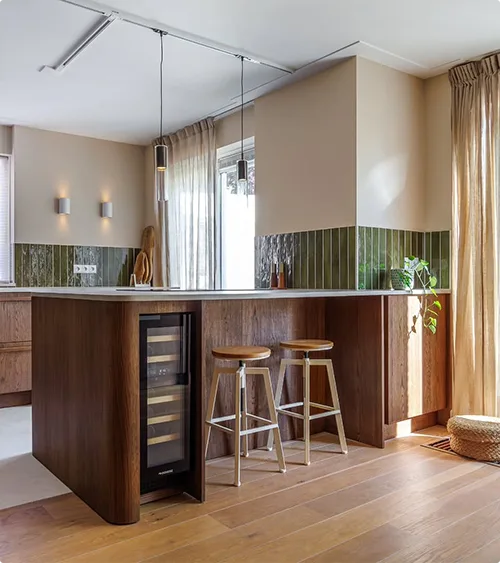
The green textured tile backsplash adds this unexpected pop of nature to the space. That big mirror above reflects everything back, making the kitchen feel twice as large.
The warm wood island has this rich, chocolatey tone that grounds the whole design. Plus there’s a wine fridge built right in, which honestly feels like a must-have at this point.
Cloud Nine
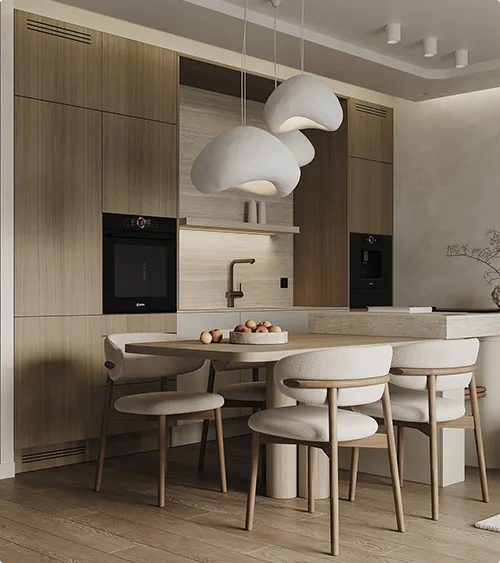
Those cloud-shaped pendant lights are doing all the heavy lifting here, style-wise. The integrated dining setup means you can cook and eat in the same zone, which makes weeknight dinners way less complicated.
The wood cabinetry has this really smooth, linear grain that feels calm. Everything’s in that sweet spot between minimal and cozy.
Stone Garden
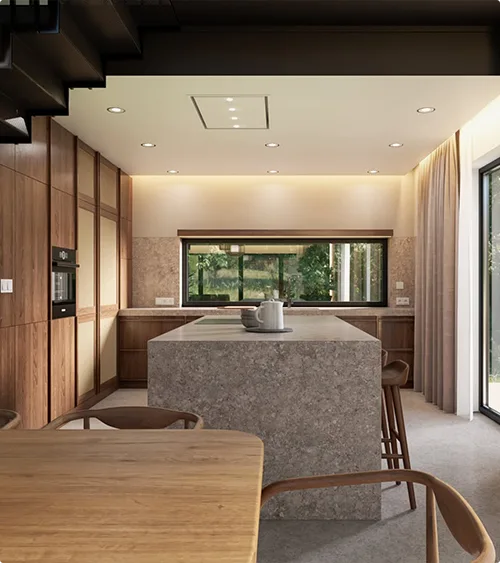
The chunky stone island looks like it weighs a thousand pounds in the best way possible. That window behind the sink frames an actual garden view, so you’re basically washing dishes while staring at greenery.
The tall wood cabinets keep storage sleek and hidden. The whole room has this earthy, grounded feeling that makes you want to slow down a little.
Everyday Elegance
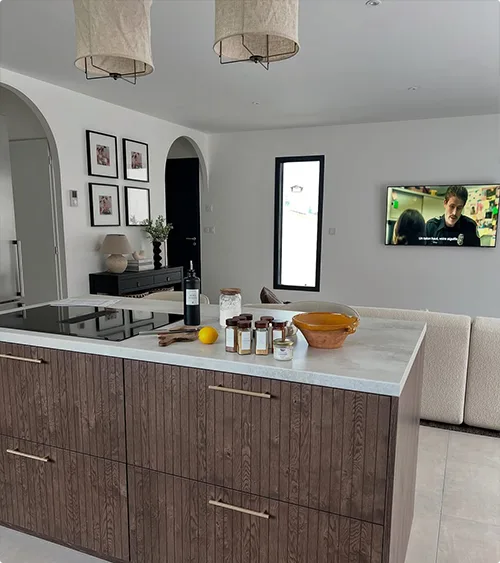
This one feels lived-in, which I appreciate. There’s actual stuff on the counter, a lemon, some jars, a bowl, like real people use this kitchen.
The dark wood grain cabinets paired with white marble counters hit that classic Japandi combo. Those arched doorways in the background add a softer architectural touch that keeps things from feeling too modern or cold.
Urban Nest
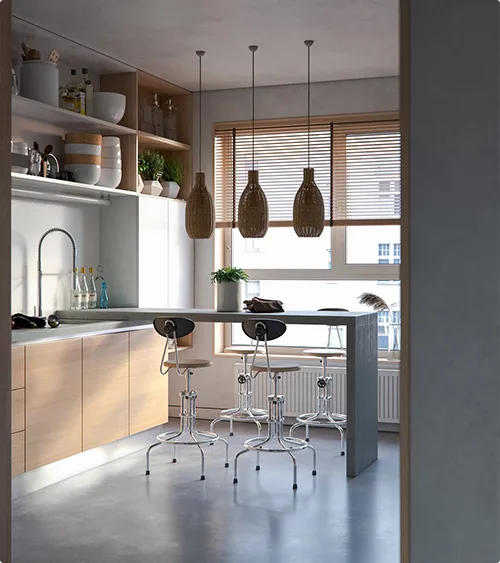
The gray walls make this smaller kitchen feel like a cozy hideaway instead of cramped. Those woven pendant lights bring in texture without taking up visual space.
Open shelving shows off your pretty dishes, which is either inspiring or stressful depending on how you feel about keeping things tidy. The concrete floor adds an industrial edge that plays nice with the light wood cabinets.
Chevron Comfort
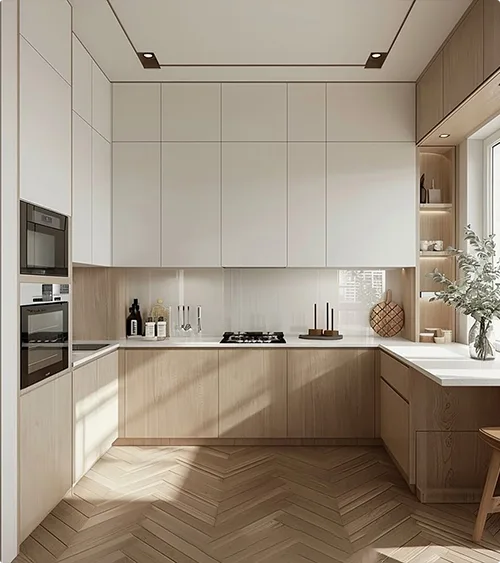
That herringbone floor is the detail that makes everything else look more expensive. The two-tone cabinets, white on top and light wood below, create this really balanced look.
The geometric ceiling cutout adds dimension without being loud about it. Sometimes it’s the small architectural touches that make a kitchen feel custom instead of cookie-cutter.
Terracotta Dreams
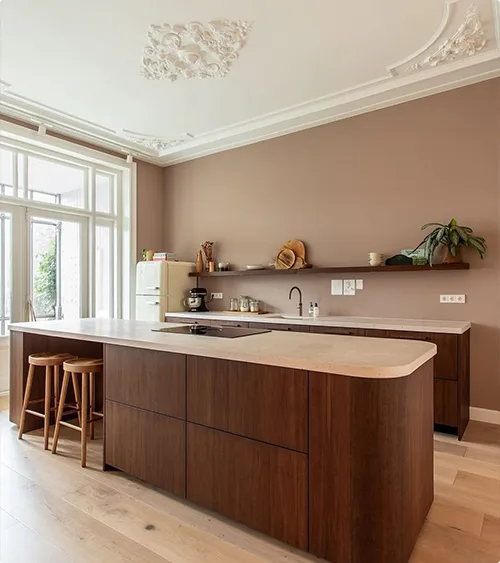
The terracotta walls are brave, and I’m here for it. They add warmth without making the space feel dark or heavy.
That floating wood shelf keeps things open and airy while giving you a spot to display a few favorite things. The dark wood island anchors everything, and those ornate ceiling details? They’re like a little nod to old-world charm mixed with modern simplicity.
Gallery Walk
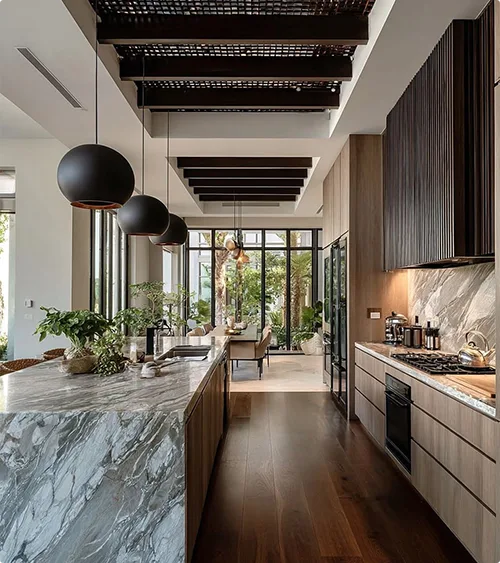
The dramatic wood-beamed ceiling makes this kitchen feel like an art gallery. Those oversized black pendant lights hang like sculptures over the marble island.
The tall ceilings and clean sightlines through to the next room create this really open, flowing space. It’s fancy but still functional, which is the dream.
Sunlit Library
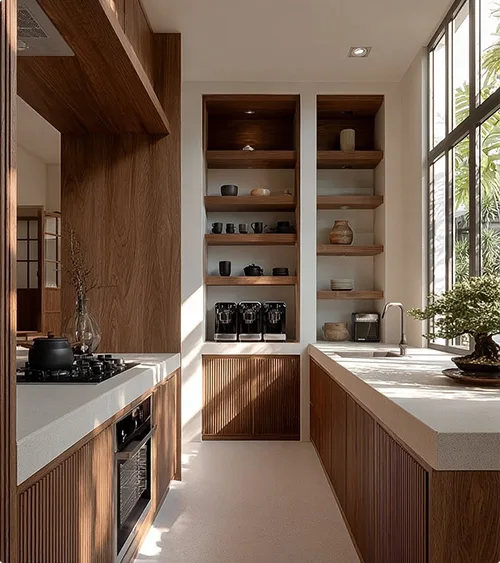
That tall alcove with built-in shelving is basically begging you to style it with pretty ceramics and cookbooks. The fluted wood details on the lower cabinets add texture without fuss.
Natural light pours in from multiple directions, which makes everything feel bright and fresh. It’s the kind of kitchen where you’d actually want to spend your Saturday morning.
Warm Embrace
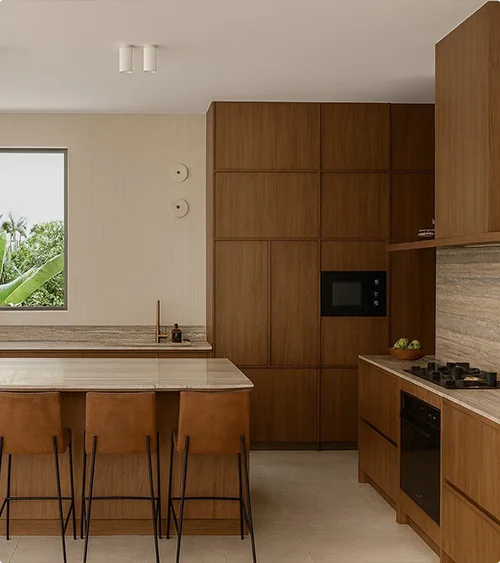
Everything here is wood, and somehow it doesn’t feel overwhelming. The color stays consistent throughout, which creates this really cohesive, wrapped-up feeling.
The minimal hardware and clean lines let the natural wood grain do the talking. Sometimes monochrome isn’t about white and black, it’s about letting one beautiful material take center stage.
Quiet Balance
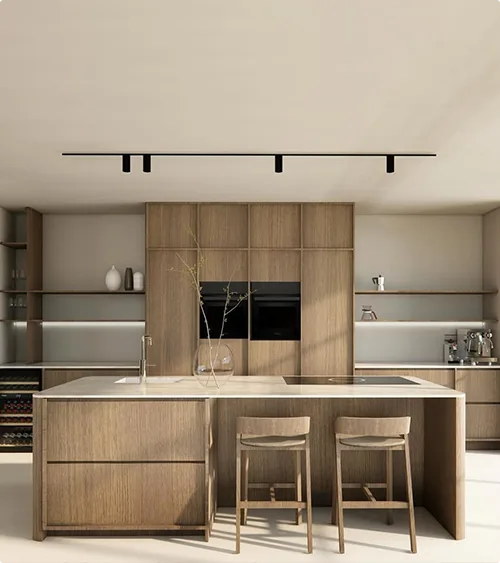
The symmetrical floating shelves flanking the centered cabinet create this really calm, ordered feeling. Everything has its place, which makes my brain happy.
That long track lighting runs down the center like a guiding line. The neutral palette keeps things peaceful, and the design feels intentional without being too precious about it.
Evening Glow
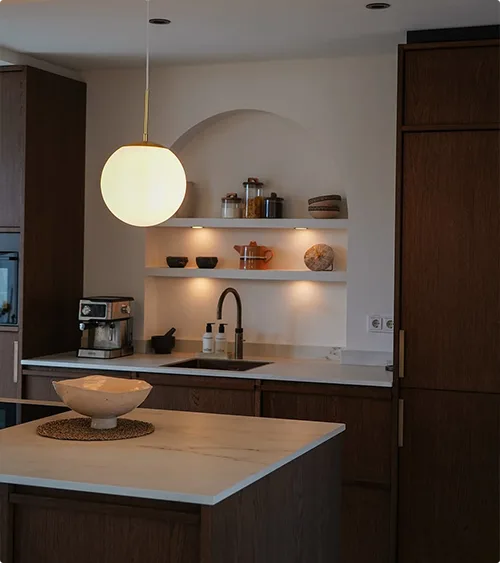
The globe pendant light creates this soft, warm pool of light that makes the whole corner feel intimate. Those floating shelves with built-in lighting show off a few favorite pieces.
The dark wood cabinets paired with white counters keep the contrast interesting. The arched niche adds a little architectural personality, like the room has its own secrets.
Cloud Gathering
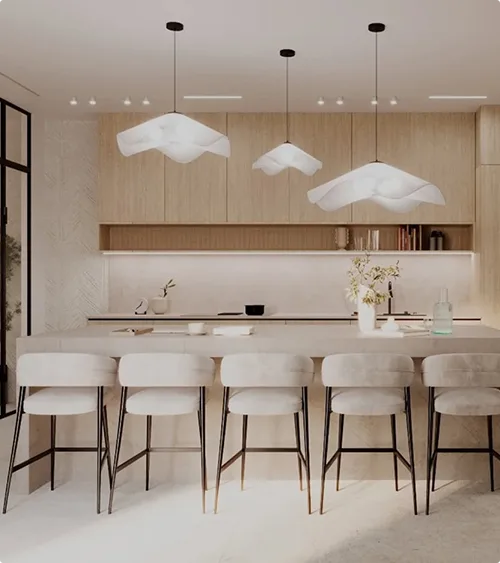
Six barstools lined up at this island means you can actually have people over without everyone crowding into the living room. Those wavy cloud pendants are playful without being childish.
The long island becomes the social hub, which is what kitchens should be anyway. The light wood and neutral palette keep things feeling open even with six people sitting there.
Gentle Curves
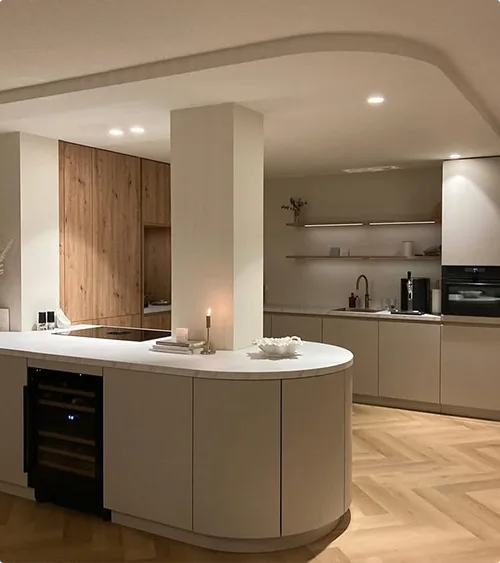
The rounded island softens the whole space and makes traffic flow easier. That herringbone floor adds pattern in a subtle, timeless way.
The sage and taupe color palette feels really soothing, like the room itself is asking you to relax. The arched architectural details echo the curves of the island, which ties everything together nicely.
Frequently Asked Questions
What colors are best for Japandi kitchens?
Stick with neutral colors like white, beige, cream, and soft grays. Then add warm wood tones for balance.
You can throw in some darker accents like black or charcoal for contrast. But the main vibe should feel light and peaceful, not loud.
What kind of lighting works in Japandi kitchens?
Natural light is your best friend here. Keep windows clear and unblocked when possible.
For fixtures, go with simple pendant lights or recessed lighting. Sculptural pendants in organic shapes work great too. Nothing too sparkly or complicated, just clean and functional.
Is Japandi expensive to achieve?
Not really. You don’t need to gut your whole kitchen.
Sometimes it’s just about editing what you already have. Remove extra decorations. Paint walls in neutral tones. Swap out a few accessories. The expensive part would be replacing cabinets, but even then you can refinish what you have instead of buying new.
Can I add color to a Japandi kitchen?
Sure, but keep it subtle. Earthy tones like terracotta, sage green, or muted blues work nicely.
The trick is not going overboard. Maybe one accent wall or a backsplash in a gentle color. You want pops of interest, not a rainbow explosion.
What materials are used in Japandi design?
Natural materials are key. Wood is the big one, especially light oak or walnut.
Stone and concrete work great for counters and floors. Linen, cotton, and other natural fabrics for any textiles. Avoid anything too shiny or plastic-looking. If it comes from nature, you’re probably on the right track.
